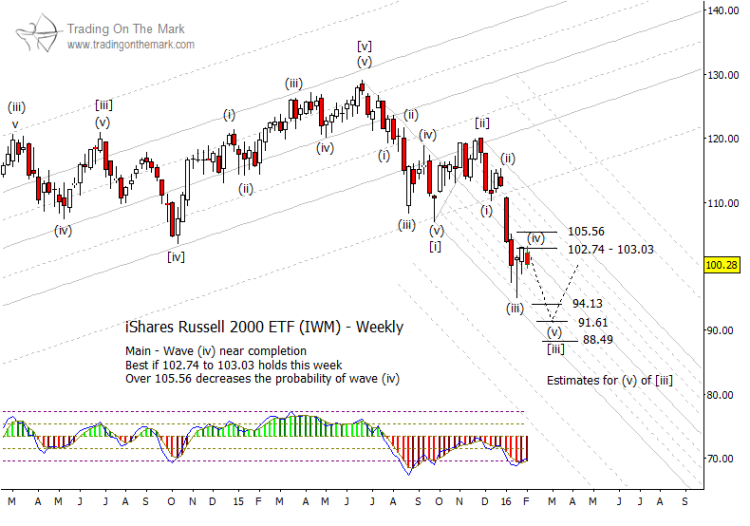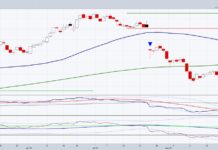As the stock indices have become more volatile in recent weeks, we have been updating our charts and targets. This post offers a quick snapshot of progress in the iShares Russell 2000 ETF (symbol IWM). The pattern analysis also applies to the Russell 2000 index itself.
In the larger picture, we expect to see a five-wave decline from the mid-2015 high which might continue until approximately 2017 or perhaps 2018. The monthly chart that was included in our December post about IWM shows the approximate magnitude we expect for the Russell 2000 decline.
While a multi-year chart like the one mentioned above can be useful to investors and traders with longer time frames, the weekly chart shown below can be helpful for those seeking to enter and exit from trades that might last weeks or a few months during the Russell 2000 decline.
On the weekly chart, the first downward wave [i] of the expected five-wave sequence probably finished in late September 2015. The upward retracement met our expectations for wave [ii], and now price appears to be declining in wave [iii]. We believe the third wave of the Russell 2000 decline can continue for several more weeks, which suggests that traders who are already in short positions with respect to the fund or the index might simply remain in those positions (while also taking steps to lock in profits and mange risk).
Russell 2000 ETF (IWM) – Weekly Chart
Traders working on faster time frames than that might look for new short entries nearby or into rallies. A closer examination of the Elliott wave formation highlights where to look amidst a countertrend rally within the broader wave structure of the Russell 2000 decline.
We know a third wave usually represents the strongest move in a five-wave sequence. Late last year, we were expecting price to move away from the upward-sloping channel as wave [ii] reached completion. The force of the downward move helped reinforce the idea that it was forming a third wave. Furthermore, by counting the sub-waves inside the move down from [ii], we see that the inside third wave (iii) was also quite strong. Those clues serve as guideposts in relation to the larger pattern.
The bounce up from the price low of mid-January 2016 occurred in about the right place for a small fourth wave to begin, still inside the larger downward wave [iii] of the Russell 2000 decline. Now that the correction in both IWM is approaching standard retracement areas near 102.74-103.03 and perhaps higher near 105.56, it may be time for faster traders to start looking again for short entries. Initial downward price targets for wave (v) of [iii] include 94.13, 91.61, and 88.49, which suggests that anyone trading down toward those levels consider exiting in whole or in part as price reaches those general areas within the Russell 2000 decline.
In keeping with the count shown above, price should begin a larger fourth wave after it finds support near one of the marked levels. Wave [iv] could consist of a net-sideways move that lasts a few months or longer, and the trading action inside that wave would probably be choppy. Eventually, price should resume its downward trend in a fifth wave [v].
While the Elliott wave count presented here is not the only viable one, it is our preferred one for now. If price falls more steeply than is suggested by the weekly chart included here, then we will move to our more bearish backup scenario.
Our next newsletter will feature charts for additional stock market indices and will also cover bonds and interest rates. Subscribe to our newsletter today! Thanks for reading.
Continued Reading: Biotech Sector (XBI) Approaching Price Area For A Rally
Twitter: @TradingOnMark
No position in any of the mentioned securities at the time of publication. Any opinions expressed herein are solely those of the author, and do not in any way represent the views or opinions of any other person or entity.









